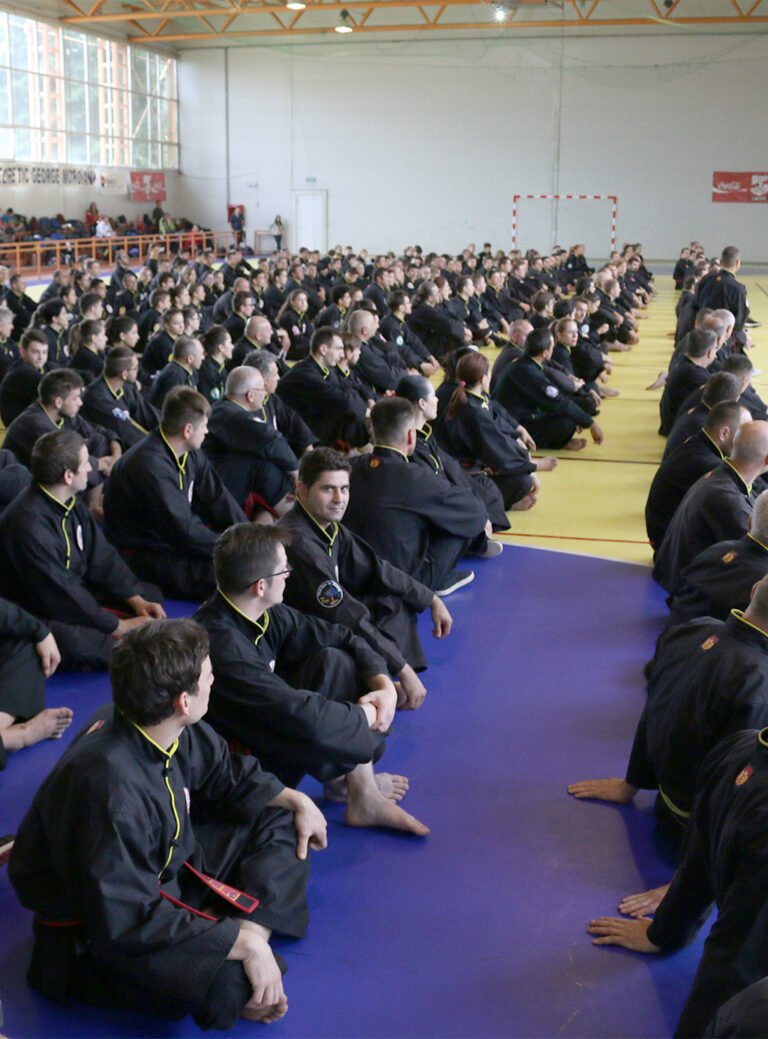
Qwan Ki Do is a very complete martial art. From this art flows several other disciplines that are integral parts of Qwan Ki Do:
- Cổ Võ Đạo: the practice of traditional weapons.
- Phong Vê: self-defense.
- Qwan Ki Do Vo Dai: free fighting.
- Công Phá techniques: breaking techniques.
- Vũ Lân: the Dance of the Dragon and the Unicorn.
- Tâm Thể: psycho-energetic gymnastics for well-being, derived from Kinh Dich (Y King).
Cổ Võ Đạo
Cổ Võ Đạo, or traditional weapons practice, is an integral part of the Qwan Ki Do program. At Cổ Võ Đạo seminars, students can learn or perfect various types of weapons, including wooden, edged, articulated, throwing, as well as agricultural utensils.
The International Qwan Ki Do Federation has established rules for the practice and refereeing of Cổ Võ Đạo competitions, reserved for practitioners who have undergone specific training. IQKDF-approved equipment guarantees safety during training sessions.
After several years of practice, students can take a level assessment exam, which includes three grades: Sơ Cấp (Initiate), Trung Cấp (Black Belt) and Thượng Cấp (High Level).


Phong Vê
Phong Vê is a discipline that focuses particularly on the notion of self-defense, and is particularly suited to situations involving attacks with bare hands, knives, etc. Among the techniques most commonly used in Phong Vê are seizure techniques and armlock techniques (dislocation of various joints such as wrist, elbow, shoulder, ankle, etc.).
Phong Vê techniques vary according to the type of aggression, and require rigorous training. Mastering an appropriate response is no simple matter, since it depends on physical ability, knowledge of defense and psychological aptitude. Faced with a potentially dangerous aggressor, the decision to act must be swift and unhesitating, as any reluctance can be fatal.
It is essential not to regard self-defense as a mere ruse. Each attack presents unique situations which may require adaptation of tactics. Victory will depend on preparation and mastery of defense techniques. Thus, a good understanding of the basics of Qwan Ki Do is crucial to an effective response, involving correct placement of hand, foot and dodge movements.
Le Qwan Ki Do-Vo Dai
Le Qwan Ki Do-Vo Dai est une discipline de combat libre. En effet, les combats demandent un engagement plus important que lors des combats de compétition de Qwan Ki Do Traditionnel puisque cette discipline autorise davantage de coups comme les coups de coude, coups de genou ainsi que ke K.O au corps et à la tête.
Different criteria are taken into account when awarding points, notably the difficulty of the combinations of techniques used, the fighting attitude, the domination of the fight, endurance and the ability to receive blows...

Công Phá techniques
The effectiveness of techniques and weapons is essential to any fighting method, and traditional Asian martial arts, such as Qwan Ki Do, have developed ways of evaluating and perfecting them.
Công Phá is a method that tests the validity of techniques by breaking materials, relying on two components: physical strength (Ngoại Lực) and internal energy (Nội Lực).
Ngoại Lực results from rigorous training, including strength-building exercises and preparation of body parts. Nội Lực, on the other hand, concentrates the body's energy to maximize power. These two elements are inseparable for successful Công Phá, which offers a variety of applications, such as the ability to break materials, withstand extreme conditions, perform silent movements or achieve objectives at a distance.
At an advanced level, Điểm Huyệt can influence an opponent's meridians. In his book “Les contes des Arts Martiaux” (Tales of the Martial Arts), Pascal Fauliot discusses this ancient medical science, which today is little mastered by the Grand Masters.
Vũ Lân
Although often confused, the unicorn (or Lion) dance and the dragon dance are fundamentally different.
The dragon dance requires a large number of participants to animate a dragon over 10 meters long, supported by a long stick, all performed to the rhythm of percussion. The unicorn dance, on the other hand, is more common and performed by two people, representing a body of around 3 meters. This dance requires great mastery of musical rhythms and the handling of the unicorn's head.
In Vietnam and China, this dance is often performed by martial arts students during demonstrations. Another dance, the lion dance, is less common and is mostly seen at festivals or in Asian circuses. These dances, symbols of prosperity and good fortune, are intended to chase away demons and attract good fortune. Traders hang banknotes from bamboos to attract these dances, reinforcing the rivalry between troupes. Often, these groups of dancers are also martial artists.

Tâm Thể
Tâm Thể, or Tâm Khí Thể, is a psycho-energetic gymnastic of Vietnamese origin, inspired by the Yi-King. It brings together various body-care techniques from several continents, aimed at improving well-being through exercises that regulate muscular tension.
During a muscle contraction, the proteins actin and myosin interact, resulting in an increase in diameter and a shortening of the muscle fiber. It's crucial to relax these muscles after an effort to restore body balance and avoid excessive fatigue.
Relaxation methods such as yoga and stretching help to reduce muscle tone. However, Asian techniques are distinguished by their integration of mind and energy, often misunderstood by Western thinking.
Learning about this energy within oneself requires progressive awareness, starting with concrete experiences before reaching more abstract concepts. This process of physical exploration leads to a deeper understanding of inner forces.

